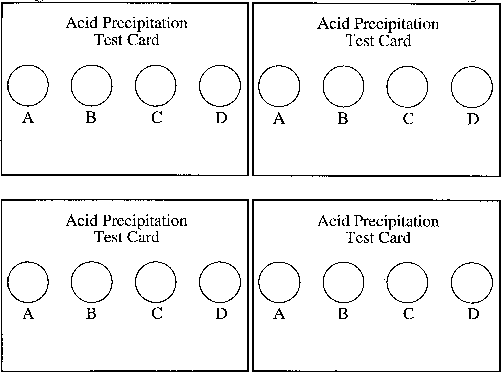 |
 |
|
|
|
|
Contributed by: New York State Education Department (NYSED)
Description:Students study descriptions of pH and determinations of acids and bases. Based on this information, they then determine which unknown solutions are more acidic. These inferences and data given from previously recorded rainfall are used to identify which sites receive the most acid rain and the affects this may have on wildlife. The task assess students' abilities to make simple observations, apply their observations to test an unknown, and make generalized inferences from their observations and apply their understanding to an everyday situation. This task is designed to take students approximately 8-15 minutes to complete.
Overall Task Content Area:
Specific Knowledge Areas:
Performance Expectations:
National Science Education Standards:8 B PS 1: Properties and changes of properties in matter: Grades 5-81.2 Substances react chemically in characteristic ways with other substances to form new substances (compounds) with different characteristic properties. In chemical reactions, the total mass is conserved. Substances often are placed in categories or groups if they react in similar ways; metals is an example of such a group. 8 A SI 1: Abilities necessary to do scientific inquiry:
Grades 5-8 1.4 Develop descriptions, explanations, predictions, and
models using evidence. Students should base their explanation on
what they observed, and as they develop cognitive skills, they should
be able to differentiate explanation from description- providing
causes for effects and establishing relationships based on evidence
and logical argument. This standard requires a subject matter knowledge
base so the students can effectively conduct investigations, because
developing explanations establishes connections between the content
of science and the contexts within which students develop new knowledge. 8 C LS 3: Regulation and behavior: Grades 5-8 National Council of Teachers of Mathematics: Algebra (AL1): Understand patterns, relations and functions. Data Analysis and Probability Standards (DAP3): Develop
and evaluate inferences and predictions that are based on data. Problem Solving (PS2): Solve problems that arise in mathematics
and in other contexts. General Instructions to the Teacher:This task is designed to take most students 8-15 minutes to complete. Students will be working individually for the experiment/activity part of this exercise. The materials should be set out at each lab station, if possible. A central supply area, if needed, should be easily accessible. All supplies should be clearly labeled.
Materials for "Acid Precipitation":At this station students should have:
Advance Preparation:Stock Solution Preparation:
For Best Results:
Safety:
|
